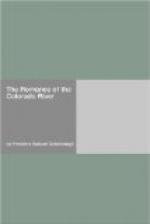All over the region the rocks are seamed by mineral veins. Some of these have already poured forth millions of dollars, while others await a discoverer. On the river itself gold is found in the sands; and the small alluvial bottoms that occur in Glen Canyon, and a few gravel bars in the Grand, have been somewhat profitably worked, though necessarily on a small scale. The granite walls of the Grand Canyon bear innumerable veins, but as prospecting is there so difficult it will be many a long year before the best are found. The search for mineral veins has done much to make the farther parts known, just as the earlier search for beaver took white men for the first time into the fastnesses of the great mountains, and earlier the effort to save the souls of the natives marked their main trails into the wilderness.
This sketch of the Basin of the Colorado is most inadequate, but the scope of this volume prevents amplification in this direction. These few pages, however, will better enable the reader to comprehend the labours of the padres, the trappers, and the explorers, some account of whose doings is presented in the following chapters.*
* In connection with the subject of erosion and corrasion the reader is advised to study the following works, which are the standards: The Exploration of the Colorado of the West, and the Geology of the Uinta Mountains, by J. W. Powell; The Henry Mountains, by G. K. Gilbert; The Geology of the High Plateaus of Utah, and The Tertiary History of the Grand Canyon District, by C. E. Dutton.
CHAPTER IV
Onate, 1604, Crosses Arizona to the Colorado—A Remarkable Ancient Ruin Discovered by Padre Kino, 1694—Padre Garces Sees the Grand Canyon and Visits Oraibi, 1776—The Great Entrada of Padre Escalante across Green River to Utah Lake, 1776—Death of Garces Ends the Entrada Period, 1781.
In the historical development of the Basin of the Colorado four, chief epochs are apparent. The discovery of the river, as already outlined in previous chapters, is the first; second, the entradas of the padres; third, the wanderings of the trappers; and fourth, the expeditions of the explorers. These epochs are replete with interesting and romantic incidents, new discoveries; starvations; battles; massacres; lonely, dangerous journeys, etc., which can only be touched upon in a volume of the present size. Dr. Coues placed the diary of Garces, one of the chief actors of this great four-act life-drama, in accessible shape, and had not his lamented death interfered he would have put students under further obligation to him.




